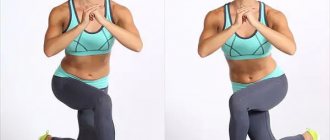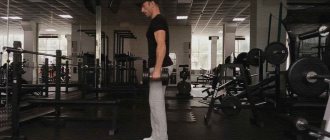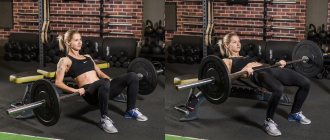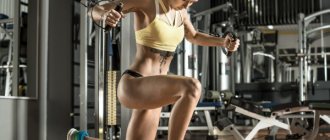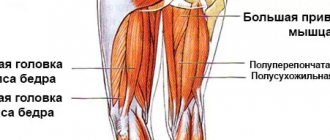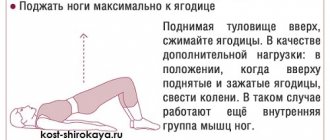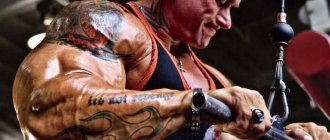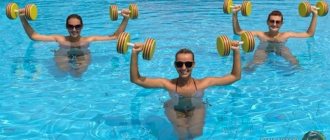Technique
What is called “breaking in” the exercise is better without weight or with nominal dumbbells or weights. If the test is successful, take on a more serious load.
The technique is as follows:
- Take dumbbells in your hands and stand straight. Feet hip-width apart, back straight, shoulders straight, gaze directed forward. This is the starting position.
- As you inhale, take a step forward with your working leg, transfer your body weight to it and bend your knee. Try to place your foot softly and elasticly, do not fall forward with your entire weight. The width of the step should be such that the knee of the working leg does not extend beyond the projection of the toe. The angle at the knee of the working leg is 90 degrees or slightly less. The supporting leg stands on the toe.
- As you exhale, push the heel of your working leg off the floor and return back to the starting position.
- Repeat the movement the required number of times.
The number of repetitions and sets depends on your individual goals:
- To gain muscle in your legs and buttocks, do 8-12 repetitions with each leg in 3-4 sets. The weight should be so heavy that the last repetitions are difficult. However, to get results, doing the exercise correctly is much more important than adding weight.
- If your goal is fat burning and definition, do 20-25 repetitions, but with light weights and at a faster pace. In this mode, you can do the exercise with weights.
As variations you can do:
- Back lunges. In this case, you do not step forward with your working leg, but backward with your supporting leg. What is the difference? There is no moment of lowering the foot of the working leg to the floor and, accordingly, the impact load on the joints is reduced. But the working leg is always under tension and is not fully unloaded as in the classic version of the exercise. Choose the execution option that is most comfortable for you. Lunges forward and backward can be alternated.
- Working leg on the platform. This version of the exercise allows you to stretch the gluteal muscle more strongly and work it out more efficiently.
- Support leg on a bench (Bulgarian lunges). Relieves the load from the supporting leg as much as possible and concentrates it on the working leg.
- Walking or dynamic lunges. This variation of performing lunges with dumbbells or weights is great for fat-burning workouts. You not only have to do the exercise, but also constantly stabilize the position of your body.
Forward lunges with dumbbells have a large number of variations, suitable for both men and women. When done correctly, in combination with other exercises for the hips and buttocks, you will make your workout as effective as possible.
More articles on topics: Hips :: Gluteus maximus :: Dumbbells :: Quadriceps :: Buttocks
Effective exercises:
- Doing deadlifts with dumbbells - who benefits from this exercise?
- Plie squat technique with a dumbbell or other weight
- Features of performing backward lunges - technique and variations
Trainer's advice: Do not blindly believe the advertisements of numerous weight loss products. If there was a “magic pill”, there would be no fat people in the world.
What types of lunges are there?
Before looking for a replacement, you need to understand what options there are for performing lunges.
Back lunges
In this case, you need to step with your supporting leg back, and not with your working leg forward. At the same time, during the exercise there is no moment of lowering the working leg to the floor, due to which the load on the joints is significantly reduced. However, the working leg in this version always remains tense, so it is better to alternate lunges back and forth.
Lunges with working leg on platform
Performed similarly to regular lunges. However, in this option it becomes possible to work and stretch the gluteal muscles as effectively as possible.
Bulgarian lunges
This option allows you to maximize the load on the working leg, while the load on the supporting leg is completely removed.
Dynamic lunges
This is an ideal option for people who want to get rid of extra pounds. The exercise is performed with weights. The main difficulty is that walking requires the ability to maintain balance.
Scissor lunges are a variation of squats for strong quads and glutes.
One of the most popular lunge variations is the standing or scissor lunge. They are used in training programs for both men and women, regardless of their goals. Using scissors, you can form voluminous quadriceps, or tighten your hips and create a beautiful shape for the gluteal muscles.
What muscles work in scissor squats?
Two main muscle groups are heavily affected:
- quadriceps femoris (rectus, vastus lateralis, vastus medialis, vastus intermedius);
- as well as the gluteus maximus and gluteus medius muscles.
During the execution, the tensor fascia lata is activated.
Features of the exercise
The great advantage of the exercise is its versatility; scissor lunges are recommended for everyone, during the period of muscle gain or cutting, when working on endurance. The exercise is a basic one; it can be performed either with free weights or in a Smith machine.
pros
- A universal exercise - suitable for men and women at any time of training.
- A multi-joint exercise that simultaneously trains several muscle groups - quadriceps and buttocks.
- Accelerates metabolism, improves both the anabolic effect on the body as a whole, and promotes the burning of subcutaneous fat under certain loads.
- Stretches muscles, allowing muscles to recover faster after strength exercises.
Minuses
- If the technique is incorrect, the knee joint may shift forward, which can cause meniscus loss.
- Balance skills are required as poor balance can lead to falls and injury.
Technique for performing lunges in place
Important! Before performing lunges, you need to warm up and stretch your muscles well!
- Stand straight, place your palms on your waist.
- Take a long step forward, placing your front foot completely on the floor and your back foot on your toes.
- As you inhale, slowly lower yourself into a squat, keeping your back knee off the floor and your front knee off your toe. The thigh is lowered until it is parallel to the floor, the knee and heel remain in the same plane.
- Do not lower your body forward, do not rotate your pelvis.
- As you exhale, lift your pelvis more quickly, keeping the entire body support on the heel of your front foot. Concentrate on strengthening your glutes.
- Perform the exercise first on the right leg, then on the left leg. Keep your balance.
- Having received a load on both legs, rest for 1 minute and proceed to the second approach.
You can make the exercise more difficult using a platform. The supporting (front) leg stands on the platform, the second - the toe on the floor. The technique of movement remains the same, do not rush to return the foot from the hill, keep your balance.
Scissor lunges with dumbbells
- Take dumbbells, lower and relax your arms, holding the dumbbells on the sides of your hips.
- Place your right foot forward, lunge to one side, then switch.
- Follow the same technique for performing the exercise as with the version without weight ↑.
Scissor lunges with pancakes
- Take one plate (depending on the required load weight) in both hands, keep your palms on the sides of the projectile. Bend your elbows and hold the plate at chest level, maintaining this position for the entire approach.
- As in the previous version, perform it on one leg, then on the other leg.
- After performing, straighten your elbows and lower the plate to the floor or bench.
Lunges with a barbell
- Place the barbell on your shoulders, take it from the floor or from the racks, observing safety precautions, tighten the weights with special locks. Hold the barbell with a wide grip.
- Take a careful step forward with your right foot, maintain balance, start with light weights.
- Perform an approach on the right, then on the left leg.
- Once completed, place your feet together and remove the barbell from your shoulders.
Smith Scissor Lunge
As with the barbell option, perform lunges in the machine, placing the bar on your shoulders - remove it from the racks, turning it with your palms, and remove the locks. Place one foot forward and the other back on your toes. Keep your knee at a right angle. With the help of a simulator, maintaining balance is much easier. Do the same amount on both legs. Scissor lunges in Smith photo
Conclusion
The scissor technique is not so simple, sometimes it requires mastering without any equipment. Beginners can perform lunges with their own weight, or using an elevated platform. Girls should master the technique with light weight; the wider the distance between the feet, the more the gluteal muscle works and stretches. Men can work with a narrower foot stance to increase stress on the quadriceps.
Squats with dumbbells
Squats are the basics and are considered one of the most effective exercises for the buttocks and thighs. But overweight people need to be careful - fat deposits will not go away, but muscle mass will increase and your hips will only become more voluminous.
What to replace it with?
You can still squat, but at first you should do without dumbbells and barbells. Start with 4-5 sets of 20-30 squats.
How to do?
Feet shoulder-width apart, toes to the sides, transfer your body weight to your heels. You can hold your hands in front of you, cross them over your chest, or put them behind your head. Lower yourself until your thighs are parallel to the floor (or lower). Keep your back straight, don't lean forward. Make sure your knees are pointing in the same direction as your feet. When getting up from a squat, do not straighten your legs completely.
Photo: istockphoto.com
How to do scissor squats
- What muscles are involved?
- Execution technique
What muscles are involved?
The load is divided between three muscle groups, namely:
- Gluteal muscles;
- Hamstrings;
- Quadriceps femoris.
The core stabilizer muscles are also used to keep the body in the correct position.
You can do the exercise either with a free barbell or in a Smith machine. If you perform in a Smith machine, you will be able to better concentrate on proper technique, since this way you almost completely turn off the core stabilizer muscles.
The emphasis of the main load can be transferred either to the front or back surface of the legs. The farther back you move your leg, the more work your gluteal muscles do, as well as your hamstrings. If you move your leg far away, the quadriceps take on the load.
Scissor squats, due to their technique, place very strong pressure on the knee joints. Even with the correct technique, the load is still noticeable. Therefore, this exercise is not recommended for those people who have any knee problems or injuries.
In addition, the fact that you are holding the barbell on your shoulders creates some stress on the spine. Listen carefully to your feelings while doing it, and don’t force yourself to do the exercise.
Execution technique
Scissor squats with a barbell are performed as follows:
Equip a barbell with a suitable weight and place it on the trapeze. For greater convenience, you can mount the barbell on a power rack that is used in a barbell squat; Place your feet shoulder-width apart; Step one foot forward
Place your foot so that during the squat your knee does not go beyond the line of your toes; The knee of the second leg should almost touch the floor during a squat; With your legs positioned correctly, pay attention to the correct position of your back. The spine is straight, and there is a natural deflection in the lumbar region; While lowering down, try not to tilt your body forward; As you inhale, lower yourself down
The leg standing behind always rests on the toe, without landing on the heel; As you exhale, return to the starting position. The legs remain in their places; Do the required number of repetitions and perform by switching legs.
Scissor squats can be performed on a Smith machine. In this case, you do not have to monitor the position of your back - since the bar is securely fastened in the machine. With this option it will be much easier for you to master the technique.
There is also a variation of the scissors execution when using dumbbells. This method is much simpler, since here it is much more convenient for you to maintain balance. Dumbbells hang freely along the body in straight arms. This is an ideal option for practicing the correct squat technique. Published by econet.ru.
PS And remember, just by changing your consciousness, we are changing the world together! econet
Lunge technique
Let's take a closer look at certain types of Bulgarian lunges:
- with a barbell;
- with dumbbells;
- and in the Smith machine.
All of them have a place in the training of athletes with well-developed leg muscles.
Lunges with a barbell
Bulgarian lunges with a barbell are performed as follows:
- Place a barbell on your shoulders and stand backwards in front of a bench, jumping box, or similar apparatus. The height of the projectile should be just below the knee. Place one foot on the bench. The further your front leg is moved away from the bench, the more your hamstrings and glutes will work. The shorter the distance, the more the quadriceps will be loaded. If you place your leg straight, the load will fall on the front of the thigh; if you turn it at 45 degrees or a little more, the adductor muscles of the thigh will also be involved in the work. We keep our back vertical and straight, trying not to bend even slightly forward. The back should be perfectly straight, the chest should be pushed up slightly, and the gaze should be directed forward.
- Lunge with your front leg. We use the back leg to maintain balance. The range of movement should be full; at the lowest point we try to touch the calf muscles with the biceps of the thigh. This requires a good stretch.
- We return to the starting position, exhaling. In order not to relax the working muscles at the top point, we try not to straighten the knee at the top and not to go through the last 5-10 centimeters of amplitude. This way the muscles will respond much better to the load. After you have completed the planned number of repetitions with one leg, switch legs.
- The most important thing in this exercise is to maintain the correct body position and concentrate on the working muscles. If you sway from side to side while lifting, the weight is too heavy. Lower the weight and increase the reps. In Bulgarian lunges with a barbell, you should work at least 12 repetitions on each leg.
Lunges with dumbbells
Bulgarian lunges with dumbbells are recommended to be performed as follows:
- Take dumbbells and place one leg on a bench. By working with dumbbells, you can shift the load to the back of your thighs. To do this, you need to move the dumbbells forward a little and bend over, leaning forward slightly. This will increase the range of motion and allow for a stronger stretch of the hamstrings, such as when performing a Romanian barbell deadlift.
- We do the lunge itself in exactly the same way, just don’t forget about the constant slight bend forward. It is recommended to perform this exercise with weights so as not to overload the hamstrings. The movement itself essentially consists of several: first we bend forward a little and “reach” forward to stretch the hamstrings, and only then we begin to bend the knee and lunge. The main thing is not to round your back when bending forward and not to try to lift a monstrous dumbbell weight.
- You can do Bulgarian lunges with dumbbells without bending forward, keeping your back vertically straight, as with regular Bulgarian lunges with a barbell. However, it will be much more difficult for you to balance there. If you want to pump up your quadriceps, then instead of Bulgarian lunges with dumbbells, it is better to do step-ups with dumbbells on a box or bench; in this exercise it will be much easier for you to maintain balance and focus on working the necessary muscles.
Lunges in Smith
Another variation of this exercise is the Bulgarian Smith Lunge. They are done as follows:
- Decide which muscle group you want to load to the maximum. If it’s a quadriceps, then the front leg should be located directly under the bar, then the load will be aimed directly at the teardrop-shaped bundle of the quadriceps. This is especially true for those athletes whose legs are asymmetrically developed and are shaped like carrots. The bench is placed about half a meter in front of the machine. If you want to use your gluteal muscles more, then move your front leg slightly forward and place the bench almost under the bar. The range of movement will be slightly smaller, but the buttocks will be under constant tension.
- The technical principles are the same as in other types of Bulgarian lunges: inhale when lowering, exhale when rising. Bulgarian lunges in Smith are convenient because you don’t need to particularly monitor the position of your back and you can completely focus on contracting and stretching the working muscle groups.
Emphasis on quadriceps and glutes
If we analyze which muscles work during lunges with dumbbells, we get the following picture:
- The quadriceps (quadriceps muscle of the thigh, occupies its anterior surface) is one of the two main working groups. This muscle extends the leg at the knee joint when we rise from the lowest point.
- The gluteus maximus muscle (makes up the bulk of the buttocks) - along with the quadriceps, experiences significant stress when extending the hip when lifting up.
In addition to the quadriceps and gluteus maximus, the following muscles take part in the work: the abdominal muscles, gluteus medius, hamstrings, back muscles, calf muscles, etc. The main function of the listed muscles in this exercise is to stabilize the position of the body and legs. It’s not for nothing that the movement is called coordination complex - it’s really not always possible to maintain balance the first time. You can also mention the arm muscles with which you hold dumbbells - they work statically.
By varying the width of your step when performing lunges with dumbbells in your hands, you can shift the load towards the buttocks or towards the quadriceps:
- The step is wider, the supporting leg has an angle at the knee of more than 90 degrees - the gluteal muscle stretches better and works more. This is the best option for most girls. However, the wider your feet are, the less comfortable it is to step and walk back.
- The step is narrower, the supporting leg is bent at a right angle - the front surface of the thigh is more involved.
The technique of lunges with dumbbells in hands allows for different step widths, with the only caveat that the legs should not be too close to each other or, conversely, too wide. Too close is when the working leg begins to extend the knee beyond the line of the toe. Too wide is when the supporting leg is almost straight. In a wide position, with good stretching, you can do lunges in place, but not dynamically.
Avoiding injuries
Lunges with dumbbells, like any other type of lunge, place increased stress on the ligaments of the knee joints. In this regard, they are more dangerous than, say, squats. This is explained by the fact that during squats, the weight of the body and weights are distributed on two legs, and when doing lunges, you focus the entire load on one leg. Of course, the muscles are delighted with this, but weak ligaments may suffer.
Therefore, to prevent injury, use the following recommendations:
Avoid lunging with dumbbells if you have a recent knee injury.
If there were injuries, but for a long time, do the exercise extremely carefully and stop if the slightest discomfort occurs. Health, you understand, is more expensive. Before you start training, you need to warm up the muscles and provoke the release of joint lubrication (synovial fluid)
To do this, we squat and do lunges without weights, rotate our feet and shins, bend forward, etc. It will take five minutes, but the effect of the workout will be much higher, and the likelihood of getting injured is lower. When working with heavy weights, do not take steps. That is, both legs remain in place and your dumbbell lunges automatically transform into scissor squats. If you have not practiced lunges before, practice the technique without weight first. If pain, discomfort or any other signals occur that should not normally exist, stop the exercise.
If, due to problem knee joints, lunges are not suitable for you, then you can try replacing this exercise by abducting your legs (swings) while standing back, forward, or to the sides. This can be done in a special simulator or on a lower block. To work the buttocks, lunges can be replaced with a gluteal bridge. But, since every injury is individual, there are no universal recommendations, and therefore it is better to consult a doctor.
Actually, let's move on to a description of how to do lunges correctly.
What can replace lunges with dumbbells?
If you have problems with knee joints or other diseases of the musculoskeletal system, then performing such an exercise will be dangerous. In order to spare your knees, you can replace lunges with weights with swinging your legs, to the sides, forward, backward. Swings are performed both in a special simulator and without it on the lower block. The glute bridge is perfect for working your buttocks; you will find information about this exercise at the end of this article. Any disease is individual, so the question of whether you can do lunges with dumbbells can only be answered by your attending physician.
Nuances
To make the exercise as effective as possible, it is worth considering some nuances and following the advice:
- There is no need to make unnecessary movements with your body and arms. That is, throughout the entire training, the upper body and arms should remain motionless.
- You don’t need to raise your legs very high; it’s best to choose the optimal height in the middle range.
- Try to keep your legs as straight as possible at all times.
- Breathe correctly when performing the exercise, taking into account your individual characteristics and intensity of performance.
- Don’t try to do everything quickly, it’s better to control the execution of each movement, and for this you need to train slowly and smoothly, observing all the technical requirements.
- If there is a need or desire to complicate the process, you can use special shin weights.
- It is advisable to do three approaches, each of which should last about a minute.
Execution technique
The technique is quite simple, but it’s worth following it, because this is what will help you achieve faster results.
- Take a supine position. Hands should be along the body. The palms are facing down.
- The legs are raised up; they should form an angle of sixty degrees, higher if possible. The main thing is that the pelvis is in a stable position.
- Using the bend of the spine, lift the lower point of the pelvis from the floor, this should be done so that the soles of the feet are located above the head. Using your hands, grab yourself under the upper part of the pelvis and secure yourself by creating a very confident support. It is also worth bending your lower back quite a bit.
- As you inhale, leave one leg completely motionless, and lower the other, pointing forward.
- As you exhale, you need to change legs.
- Do the exercise ten times with each leg.
- When the training is completed, the legs are brought together and the body lies completely on the floor or mat.
- This exercise is a more complex version of scissors, which is suitable for more physically prepared people and gives maximum results.
Now let’s look at a simpler and many familiar option:
- Take a supine position, preferably on the floor.
- The legs should be placed together and in a straight position.
- It is best to place your hands under your buttocks, this will provide better support for your back.
- When performing the exercise, the back is pressed as close as possible to the floor and should not come off it. Since this determines how effective the training will be.
- You need to suck in your stomach and inhale air.
- Raise your legs about seven centimeters from the floor, do this synchronously and cross them.
- Make wide swings from side to side, placing your legs on top of each other.
- The toes of the feet should be extended as much as possible.
Side bends with dumbbells
If you want to reduce your waist size, don't do this exercise too hard. It pumps up the oblique abdominal muscles and visually only enlarges this part of the body.
What to replace it with?
You can perform the same exercise, but without weights or with 1.5-2 kg dumbbells. The exercise should be done no more than once a week.
How to do?
Place your feet shoulder-width apart, place one hand on your belt or behind your head. Tighten your abdominal muscles and slowly lean to the side, keeping your back straight. Do 10-15 bends in one direction, then change sides.
Top 7 “forbidden” foods that hinder perfect abs
You can also perform a side plank - this exercise will put stress on the oblique muscles, but will not increase them.
How to do?
Lie on your side and lean on your elbow. Keeping your back straight, lift your hips off the floor and hold your body in this position for as long as possible. Lower yourself to the floor and switch sides.
Photo: istockphoto.com
Scissor squats or standing lunges
Muscle work
You can shift the emphasis of the load to the front or back muscle group. It depends on the width of your legs. The further the leg is set back, the more the gluteal muscles and the back of the thigh are involved. By bringing your legs closer together, you force your quadriceps to work.
As a word of caution, the step-up, like any other lunge or barbell squat, places significant stress on the knee joints. Of course, proper technique should minimize this, but it is best to avoid this exercise if you have knee pain or injury. Also, carrying weight on your shoulders puts compression on your spine.
Pay attention to this if you have back problems
How to do?
Take a projectile of a comfortable weight and place it on your shoulders just below your neck. The bar should rest on the trapezius muscles. When working with a barbell, it is more convenient to take it from racks that suit your height than to lift it from the floor every time. Stand with your feet shoulder-width apart and step one foot forward. The width of the step should be such that when squatting, the knee of this leg does not go beyond the line of the toes. The second knee should either almost touch the floor directly under the body, or be moved further back (long lunges). Having placed your feet in the desired position, check the position of your back. The spine is straight, the weight presses on it strictly perpendicular to the floor, there is a slight natural deflection in the lower back. Try not to bend forward while doing the exercise, as this will change the vector of the weight, and the load on the spine can become traumatic. As you inhale, bend your knees. In a squat, the center of gravity of the body should be in the center, between the legs
It is important not to move it back. The leg standing behind is always on the toe and does not fall on the heel
Also try not to touch the floor with your knee. As you exhale, using the force of both legs, stand vertically up. The position of the feet does not change from repetition to repetition, you do not need to step, as classic lunges imply - the body only moves up and down. Do the required number of repetitions, rest and proceed to the next approach.
If you do such lunges not with a free barbell, but in a Smith machine, then you do not need to monitor the vertical position of the body - the machine will do it for you. This embodiment is preferable from the point of view of ease of mastering the mechanics of movement.
Smith machine variation. The dumbbell scissors variation is also simpler than the barbell variation. The fact is that with dumbbells it is much easier to maintain balance. Therefore, if the Smith machine is not available to you, and you are still leaning to the sides with a barbell, start with this option. You will work on the technique, learn to coordinate the work of muscles, and then move on to a more complex projectile. Dumbbells should be held with your arms extended to the sides of your body.
Variation with dumbbells. If you are a beginner and have no training experience, try doing lunges in place without any weight at all. In your case, even doing this will give a noticeable effect.
Inclusion in training
Before starting the exercise, warm up your leg muscles, joints and ligaments. To do this, you can work out on a treadmill, do one set without weights, and do some dynamic stretching exercises. This is required to minimize the likelihood of injury.
When working to gain mass, it is recommended to perform scissors or lunges in place 8-12 times in 2-3 approaches. Choose a weight so that at the end of each approach you feel severe muscle fatigue. If some muscle group (for example, the gluteals) is not tired enough when performing such squats, finish it off with isolating exercises.
One of the advantages of the cross-step exercise is that it allows you to train the right and left legs separately to the required extent. The movement engages the largest muscles of the lower body and, when performed regularly, produces excellent results.
Technique for performing lunges with dumbbells
Learn the technique of performing the exercise and practice it without weights, then, when you are confident in the correctness of your actions, connect dumbbells.
Starting position - standing straight with shoulders back, dumbbells in hands, feet hip-width apart, neck straight, gaze fixed in front of you. Take a step forward while inhaling, the foot is placed softly, the body weight is transferred to the working leg, it bends at the knee, this should happen smoothly, you cannot fall with all the weight on the leg.
With the correct step length, the knee of the working leg will not go beyond the level of the toe, the angle of the leg at the knee will be no more than 90 degrees, and the second leg will stand on the toe.
In order to return to the starting position, make an entrance and at the same time push off the heel of your working leg from the floor. Do the required number of lunges on one leg, then switch legs.
This exercise is a basic exercise, so it can be done after doing squats, deadlifts or leg presses. How many sets you need to perform and how many sets there will be in each of them depends on what you want to achieve.
To increase muscle mass in the buttocks and legs, you should do 3-4 sets of 8-12 repetitions for each leg. In this situation, the weight should be serious; if the last repetitions are given through force, then you are doing everything right. Don't forget about technique; it is much more important than increasing the weight of the dumbbells.
If your goal is to lose excess weight or develop muscle definition, then you need to do 20-25 repetitions at a faster pace and with light weights. When performing in this mode, you can connect additional weights.
How to do butt lunges at home
- While performing the exercise, control your breathing. Tension is on exhalation, relaxation is on inhalation.
- If this is your first time deciding to do this type of gymnastics, consult with a trainer.
- Perform a light, muscle-warming warm-up to stretch those muscle groups that will work (buttocks, front and back of the thigh, lower leg). By doing a warm-up, you can avoid injury during your main workout.
- At the beginning of the workout, do not do deep lunges, do not lower your body completely. Stretch your muscles gradually until they adapt to the load.
- The leg that you put forward bends only at a right angle. and the knee does not go beyond the line of the fingers. Otherwise, the knee will experience the greatest load, which threatens to injure it. The potential for damage to the knee joint is quite significant if performed incorrectly.
In the ranking of the TOP 10 exercises for the buttocks, “Vertical lunges” take 2nd place.
When doing this movement with solid weights, remember that you are pumping up primarily the muscles of the legs, not the buttocks.
How to do lunges with dumbbells
To perform this we will need two dumbbells of decent weight. As a rule, this exercise is performed with dumbbells with straight arms. Some athletes throw dumbbells over their shoulders. In my opinion, this is, firstly, inconvenient, and secondly, it is fraught with loss of balance.
So, let's pick up dumbbells. We hold them on straight arms on the sides of the body. Feet approximately shoulder width apart. Keep your back straight and look straight. This is our starting position.
Take a deep breath and step forward with your right foot. The left leg remains in place. We lower ourselves until the angle at the right knee joint is approximately 90 degrees, and the thigh is parallel to the floor. The left leg is slightly bent at the knee joint, the left foot rests on the toe. Hands with dumbbells are perpendicular to the floor. Keep your back straight, slightly arched at the lower back.
After a second pause, we push off the floor with our front leg and, using the muscles of our legs and buttocks, return to the starting position. Let's exhale. Then we lunge with our left leg. The technique is the same. In principle, you can change legs after each repetition, or do a separate approach on the right leg, then on the left. It's a matter of taste.
Lunges with dumbbells are an excellent exercise for polishing muscles. It should be performed on the day of leg training after the main basic exercise, for example, after squats or leg presses. Can be done at the end of a workout. 3-4 sets of 8-12 repetitions on each leg are enough.
Nuances
The wider the step forward, the greater the load placed on the gluteal muscles of the front leg, and the more tension the thigh muscles of the rear leg experience. However, you should not use too wide a step, as this can lead to loss of balance. In general, this exercise requires the athlete to have excellent coordination and a sense of balance. So if you have problems with this, practice first with your own weight or very light dumbbells.
In general, girls especially love this exercise, precisely because it forms attractive buttocks.
Throughout the entire approach, keep your back straight and slightly arched at the lower back, this will protect you from back injury. Look straight ahead. If you look down at your feet, your back will reflexively round. Take care of it, we will still need it for deadlifts. Just a joke of course.
There is a variant of performing this exercise when, after reaching the lowest point of the amplitude, you do not return the leg to its original position, but simply take a step forward with the other leg. It turns out to be a kind of walking with dumbbells in your hands. This requires a certain space, in addition, you need to make sure that some bespectacled newcomer does not fall under your march.
Lunges with dumbbells: how to do them correctly, what exercises there are and how to replace them
Types of exercises
The main types of lunges (they differ in the emphasis on muscle groups):
- Forward with dumbbells . From a standing position, alternate lunges forward with the right and left legs. The back is straight, the abs are tense. Hands hold dumbbells tightly. Weight is evenly distributed throughout the body. Exhale through the mouth is done with effort (when returning to place), and inhale through the nose - when lunging. This version of the exercise works the buttocks and thighs.
- Back. From a standing position, lunge backwards while inhaling. The starting position is the same. Hands tightly grip dumbbells. Body weight is evenly distributed: the body does not collapse. As you exhale, the body returns to its original position. Repeat the same on the other leg. The thigh muscles receive greater load.
- To the side. Lunges are performed alternately to the right and left. The body is slightly tilted forward, the back is straight. The abdominal muscles are retracted. Hands with dumbbells are lowered in front of you. At the end point, maximum emphasis and weight are shifted to the gluteus medius muscle and the inner thigh of the working leg.
- Diagonally (curtsy). From a standing position, alternately lunge backwards diagonally. The starting position is the same. Hands with dumbbells are lowered along the body. Exhale when returning to the starting position (with effort), inhale when lunging. The gluteus medius muscle is actively working.
- Walking with dumbbells . From a standing position with a straight back, you need to lunge forward with one leg, inhaling. The abdominal muscles are tense. The weight is distributed evenly over the body: the body does not fall forward, backward or to the side. Hands with dumbbells are lowered along the body. As you exhale, return to a vertical position and take a step again, but with the other leg. The muscles of the hips and buttocks work. The most energy-intensive exercise option.
- Combined. Lunge forward with your right leg while inhaling, return to the starting position, exhaling. Immediately after this, lunge to the right and come back. Then lunge back and return to a standing position. Repeat everything on the left side. This version of the exercise allows you to target all problem areas of the hips and buttocks.
Beginners can do all of the above exercises with their own weight, gradually increasing the number of repetitions and adding weight.
About the benefits of the front squat
Squats with a barbell and dumbbells have a number of advantages over other exercises:
- a large group of muscles is involved and the hips develop well, the lower back and abs improve;
- reducing the load on the back, which prevents knee injury when squatting;
- the possibility of correctly performing the technique, otherwise the bar will begin to fall and an attempt will occur to hold the weight with your back, which will result in a correspondingly greater load on the back and possible fractures of the spinal vertebrae;
- development of stability of movements and formation of muscle performance;
- promoting better and faster fat burning and tightening of the involved muscles.
All of these advantages allow athletes to choose these exercises, and coaches to use these exercises when drawing up a training plan. Girls can also do the front squat, as it is an excellent option for losing weight. The main thing is to choose the right weight.
Chips: the right equipment
A fairly small number of people pay due attention to such important details as clothes or shoes. Although these are not unimportant components of each training session.
For squats of any kind, as well as lunges, it is recommended to choose shoes with a thin heel, which means a low heel. Shoes with a smooth surface, soft sneakers or sneakers are not suitable here.
To give additional stability to the body and comfortable balancing, you need to use wooden plates or pancakes. They should be placed under your heels. This is a particular plus for people with flat feet.
An important point is the placement of the hands on the bar. After all, they can be held not only crossed, but also with a regular grip. We can say that most beginners will not like the crossed style. After all, it is difficult to constantly control the parallel position of the elbows relative to the floor, and at the moment of instability, the barbell may roll off. In the classic position, performing the exercise will be easier and safer.
Regarding clothing: the material of manufacture should perfectly absorb excess moisture and not be slippery. To prevent the bar from sliding, talk or chalk is used, which is applied to part of the chest and neck, which will improve the contact of the bar with the body of the practitioner.

